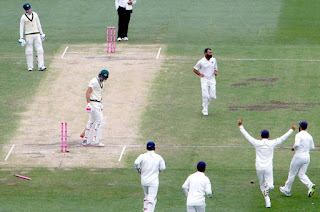what is follow on in cricket
Following-on or follow-on is a standard in Test cricket which requires teams that are batting second to bat once more immediately after the first innings is over.
When playing Test cricket, the follow on can only be enforced when the first team to bat achieves an advantage in the first innings of at minimum 200 runs.
If the team that is batting second has a significantly lower number of runs than the first team's total The leader of the team that bats first has to make a choice regarding whether to enforce the follow-on of the second team or to continue the initial sequence of play in which they themselves play their second innings.
By enforcing follow-ons, you can reduce the likelihood of a draw permitting the second team's innings to be completed earlier.
Follow-ons are generally a style of cricket in which teams bat twice, including domestic first-class cricket, as well as the international test cricket. In accordance with Law 14 in the MCC Laws of Cricket There is a minimum amount of lead needed by a team that defends to force the follow-on.
In a five-day game one side that bats first and has a lead of minimum 200 or more can choose to force the follow-on. If it's a three-day match or a four-day game the lead should be at minimum 150 is required and 100 in an ODI match.
It is at the Captain of team that batted first in order to force the follow-on based on various elements such as pitch as like weather conditions, remaining time in a game as well as any weaknesses or strengths of opponent.
Also Read what is mentor in cricket
Benefits of having the follow-on rule in Test cricket
The primary reason for imposing the follow-on is to force the outcome and eliminate drawing out, placing more pressure on opponents as they've already recorded an under-par score in the past.
Also, it has a huge impact on bowlers' mood because they have the responsibility of taking an additional 10 wickets while momentum is to their side, having been able to beat the batsmen from the opposition.
This tactic also sends a message of aggression to the opposition . This could be a psychological victory of kind by putting them off the sidelines after having been cheaply tossed out once.
Aslo Read Organize your First Tournament For FREE on CricHeroes
Advantages of having an after-on in cricket tests
There are some negatives to imposing an additional follow-on, the most significant is the chance of bowlers exhausting themselves after one full innings. The bowlers may not be in their best during the second innings and that might let the batting team become more at ease and add runs to the board.
Following-on is also a sign that you must bat last, which could not be a good idea in some instances, given the wear and tear on the pitches in the final couple of days of a Test.
The widening of cracks and the deterioration of the surface aids the bowlers of the opposing team more. Batting last in the match in a Test is usually challenging.
A iconic instance of a team winning an event after being told to follow-up was the famous India against Australia Test at Eden Gardens, Kolkata where hosts were able to turn the tables on the Australians, and then came back after being asked to continue to win a historic match.
The occurrences over time have led captains to reconsider their method of imposing the follow-on even though being in the position to do so generally signifies which team has control of the game.




Comments
Post a Comment